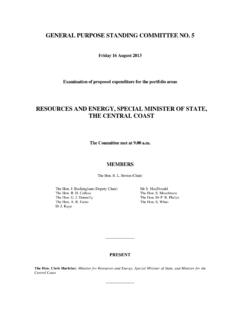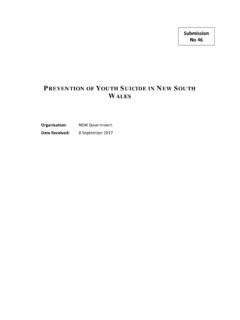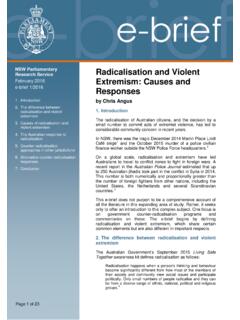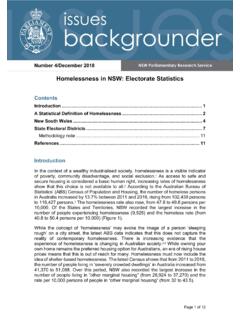Transcription of What works to promote emotional wellbeing in older people
1 What works to promote emotional wellbeing in older peopleA guide for aged care staff working in community or residential care 1300 22 4636 Yvonne Wells: with Sunil Bhar, Glynda Kinsella, Catherine Kowalski, Monika Merkes, Allison Patchett, Barbara Salzmann, Karen Teshuva and John van HolsteynAbout the authorsYvonne Wells, Catherine Kowalski, Monika Merkes, Karen Teshuva and John van Holsteyn are staff of the Australian Institute for Primary Care and Ageing (AIPCA) at La Trobe Kinsella is Director of postgraduate programs in the School of Psychological Sciences at La Trobe Bhar is a senior lecturer in psychology at Swinburne Patchett is General Manager, Innovation and Development, at Uniting Salzmann (formerly Parker, formerly of La Trobe University) is Senior Research Officer at SuperFriend IFF Mental Health to Nancy Pachana and Gerard Byrne (University of Queensland)
2 , Roderick McKay (University of NSW), Bernie McCarthy (McCarthy Psychology Services) and Rosanne Fleming (Fleming Care) for their assistance as members of our expert to the many other people who assisted this project by piloting this booklet within their organisations, including Benetas, Brotherhood of St Laurence, City of Ballarat, City of Whitehorse, Millmerran Centenary Retirement Village, South East and Illawarra Area Health Service, St Paul de Chartres, SuperFriend and Uniting to Uniting AgeWell for providing the images on pages 23, 25, 29, 50, 53, 60, 62, 65, 78, 81, 92, and 97. Thanks to Rajiv Khosla, La Trobe University, for permission to use the image on 86, to ACH Group for the image on page 55, Feros Care for the image on page 67, Humour Foundation for the image on page 34, Alzheimer s Australia Tas for the image on page 47, Amana Living on page 51 and the Delta Society for the image on page studiesThank you to the Victorian Department of Health (DH) and Uniting AgeWell for providing many of the case studies in this booklet.
3 The Victorian DH case studies were taken from the Well for Life resource and ASM Prepare. A full list of case study sources is provided on page : Beyond Blue Ltd Suggested citation: Wells, Y., Bhar, S., Kinsella, G., Kowalski, C., Merkes, M., Patchett, A., Salzmann, B., Teshuva, K., & van Holsteyn, J. (2014). What works to promote emotional wellbeing in older people : A guide for aged care staff working in community or residential care settings. Melbourne: : 978-1-921821-08-0 1 ContentsIntroduction 2 What is emotional wellbeing ? 3 What are anxiety and depression? 4 Getting help for older people with anxiety or depression 9 How to use this booklet 11 How this booklet was developed 13 What to do before you start 14A summary of what works for emotional wellbeing in older people 16 Physical activity 21 Exercise 22 Gardening and nature-assisted therapy 24 Laughter therapy and laughter yoga 26 Tai chi and qigong 28 Yoga 30 Relaxation 33 Humour therapy 34 massage 36 Meditation 38 Reiki 40 Relaxation training 41 Sensory stimulation 43 Aromatherapy 44 Bright light therapy 45 Snoezelen 46 Music and arts 49 Art therapy and craft 50 Dance and movement 52 Music and singing 54 Social activities 57 Animals and pet therapy 58 Buddying and befriending 60 Intergenerational programs 62 Men s Sheds 64
4 Volunteering 66 Reflection 69 Life review 70 Prayer and spiritual counselling 72 Simple reminiscence 74 Education and skills training 77 Bibliotherapy and self-help 78 Cognitive and memory skills interventions 79 Interventions that rely on technology 81 Computer-aided therapy and computer games 82 Phone and telemonitoring 84 Robot companion 85 Simulated presence therapy 87 Quality of life approaches 89 Behavioural activation and pleasant events 90 Dementia care mapping 93 Person-centred care 95 Restorative approaches 98 Interventions for carers 101 Education, social support and skill-building 102 Interventions that rely on technology 104 Mindfulness-based approaches 105 Psychological interventions and counselling 106 Mixed interventions 107 Interventions delivered by mental health professionals 109 Acceptance and commitment therapy 110 Cognitive behaviour therapy 112 Interpersonal psychotherapy 114 Life review therapy 115 Mindfulness-based approaches 117 Narrative therapy 118 Problem-solving therapy 120 Interventions useful for people living with dementia or cognitive impairment 122 Interventions reviewed but no research evidence found 123 Planning your evaluation 124 References 128 Case study acknowledgements and permissions 1362 What works to promote emotional wellbeing in older
5 PeopleIntroductionThis booklet has been designed for staff working in community or residential aged care services. It covers a range of interventions that can be used to promote emotional wellbeing or to help people with anxiety or depression. These interventions are grouped by type, for example, physical activity interventions, and interventions to do with music and the arts. Some interventions are supported by a lot of scientific evidence, but others are not. This booklet summarises the strength of evidence for the use of each intervention in each setting, and whether its usefulness has been shown for promoting emotional wellbeing , as well as specifically for anxiety and depression. Most sections include a short case study to demonstrate how the interventions may be used with older people in aged care booklet also includes a list of interventions that staff may want to consider if their clients or residents have dementia or memory , this booklet provides some advice to community and residential care staff on how to plan an evaluation of whether or not an intervention has made a booklet focuses on psychosocial interventions that can be used in community settings or residential care.
6 Psychosocial interventions include any interventions that emphasise psychological or social approaches, rather than biological interventions such as medications. For information about neurobiological and pharmaceutical treatments, go to is emotional wellbeing ?What is emotional wellbeing ? emotional wellbeing includes satisfaction, optimism, self-esteem, mastery and feeling in control, having a purpose in life, and a sense of belonging and Well for Life resource published by the Victorian government identifies five components crucial to maintaining an individual s emotional wellbeing :1. Resilience and coping2. Being productive and making a contribution3. Social connections4. Basic needs and comfort5. Enjoying sensory and emotional wellbeing are often grouped together: being socially and emotionally well means being able to make the most of your abilities, cope with the normal stresses of life, and contribute to your community.
7 For people of working age, it also includes working Unity and Deakin University have researched emotional wellbeing in Australia for over 10 years. The Australian Unity wellbeing Index measures subjective wellbeing and our national and personal satisfaction with life. Their report defines subjective wellbeing as a normally positive state of mind. It is a long-lasting, deep sense of contentment. Generally, people s sense of wellbeing is stable. It is only when the challenges in life become overwhelming that our psychological stability fails and our happiness suffers. Normally this loss of happiness is short-term, but if it is prolonged and fails to recover, it can result in can download the Well for Life resource at and find out more about the Australian Unity wellbeing Index at information about promoting wellbeing in Indigenous Australians, visit works to promote emotional wellbeing in older peopleWhat are anxiety and depression?
8 Anxiety is more than just feeling stressed or worried. For a person experiencing anxiety, anxious feelings cannot be brought under control easily. Anxiety is a serious condition that makes it hard for a person to cope with daily is more than just a low mood it s a serious condition that has an impact on both physical and mental common are anxiety and depression?Anxiety and depression are common in Australia. In any one year, over 2 million Australian adults have anxiety and around 1 million have depression. In older Australians, while the precise rates of anxiety and depression are not yet known, it is thought that about 10 per cent of older people in the community experience anxiety and 10 15 per cent experience Rates of depression in older people in the community who are frail and need support to remain at home are much higher than those of their healthier counterparts.
9 Rates of depression among people living in residential aged care facilities are even higher. An Australian study found that nearly 35 per cent of people living in residential care facilities were Less research has been done into anxiety but studies from the Netherlands found that about 6 per cent of older people in residential aged care have anxiety, while 30 per cent have some symptoms of Rates of anxiety and depression are also quite high in particular groups of older people living in the community. For example, the spouses of people with dementia have a fourfold higher risk of a diagnosis of depression than the spouses of people who do not have anxiety and depression are different conditions, they share many causes and some symptoms, and it is not uncommon for anxiety and depression to occur How do you know if an older person has anxiety?
10 The symptoms of anxiety can often develop gradually over time. Given that we all experience some anxiety, it can sometimes be hard to know how much is too much. To be diagnosed, the anxiety must have a disabling impact on the person s life. There are many different types of anxiety. While the symptoms for each condition are different, some common symptoms are listed awo arksotp arm moewoiisnrlCommon symptoms of anxietyBehaviourPhysical symptoms withdrawing from or avoiding situations that cause anxiety urges to perform certain rituals to try and relieve anxiety not being assertive ( avoiding eye contact) difficulty making decisions being startled easily increased heart rate/racing heart shortness of breath vomiting, nausea or stomach pain muscle tension and pain ( sore back or jaw) feeling detached from your physical self or surroundings having trouble sleeping ( difficulty falling or staying asleep)






